When I hear the phrase ‘sales pitch,’ I have ambivalent feelings about it. On the one hand, it’s just something inevitable, something every sales rep has to deal with. On the other hand, there’s…well…negative shade to it. Pitch? Really? I don’t like people pitching me any sort of thing.
Mulling over this confusion, I dare to infer: a good sales pitch can’t be pitchy.
Otherwise, it will make your prospects experience not the best feelings.
But what makes a sales pitch good? In this post, I’ll answer this question and share sales pitch examples and templates to make your pitch not pitchy but perfect.
Outline:
What is a sales pitch?
A sales pitch is a concise sales presentation in which a salesperson makes a sales offering. They explain their business and non-intrusively show the value of their product/service. Salespeople commonly make their sales pitch at least once a week, so for sales teams, this is a regular part of the sales process.
You might deal with various sales pitch types depending on which channel you use for it:
- Cold calling. ‘Call the damn leads’ – the phrase you might have heard hundreds of times, which reflects how you can reach a sales prospect with your offering – by phone.
- Email outreach. Alternative to calling a prospect, you can use email to present your offering.
- Social selling. You can contact your prospects on various social media platforms like LinkedIn, Twitter, Facebook, Instagram, and more.
- Elevator pitch. You typically use it at business events or when meeting someone in your industry for the first time.
Interestingly, you might come across the term ‘elevator pitch’ as just a synonym for ‘sales pitch.’ It emphasizes the very short time frame within which a sales pitch should be made – within the time of a single elevator ride.

Elements of a good sales pitch
I won’t tell you that your sales pitch must have a strict structure. To be honest, I’d prefer to deal with creative sales reps who afford a sort of freedom, as they sound more personal and emanate credibility.
Anyway, creativity is something that should follow knowledge. So, if you’re planning to get some understanding of how a good sales pitch differs from a bad one, I would say that a good sales pitch is commonly based on 6 essentials and advise that you keep them in your pitch.
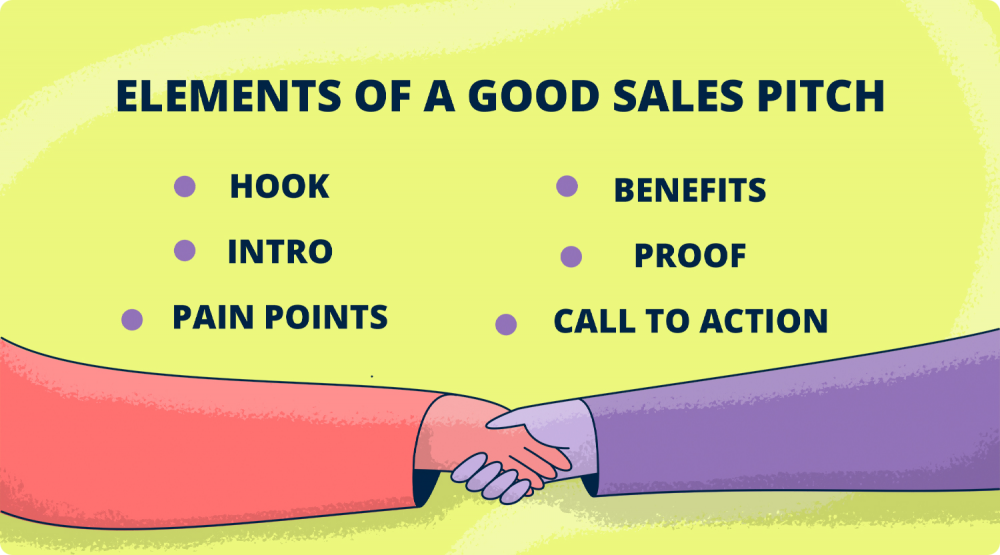
1. Hook
When you contact a person for the first time, you can’t expect them to embrace you with both arms wide. Just put yourself in their shoes; what would you think? I bet you’d think, ‘What do you want from me?’
There must be something that will show them you are not a stranger – a good hook. As a salesperson, you should do thorough research and find information about the prospect that will let you catch their attention from the start.
You’ve read a prospect’s post? You’ve heard their company launched a new product? Or maybe you’ve just looked through their LinkedIn bio and think you have much in common? All this information can work well.
Here are some examples of hooks you can use:
“I see you’ve been promoted to the position of ___. Congratulations!”
“I’ve read your post about ____. I find your tips really useful.”
Alternatively, start your pitch with a direct explanation of why you’re contacting a person:
“The reason I’m calling/emailing is that ____.”
2. Intro
Even after impressing the prospect with your hook, you’re still a stranger to them. It’s time you told them a bit of information about your company. Just be careful here: you might be tempted to speak/write a lot. Resist it. Your intro must be short and straightforward, something like this:
“I am a sales manager at ____. Our company specializes in ____.”
Simple.
3. Pain points
You’re making a sales pitch without pitching, remember? In your sales pitch, you’re not someone who is selling; you’re someone who is helping the prospect solve their problem. Your task is to identify your prospect’s pain points and highlight how your solution can help.
For example:
“I’ve read your company is using multiple services for ____, _____, and _____. It looks like you’re spending a lot of money on monthly subscriptions while your team has no single platform for cooperation.”
4. Benefits
I would say that’s the most crucial element of your pitch, your best moment to convince the prospect to buy your product/service.
Sadly, but very often, salespeople mix benefits with features. Don’t do this. In fact, your prospects don’t want to hear how excellent your solution is. They want to hear what they’ll get; they want a result.
Provide them with your value proposition.
Try to create a vision of success your prospect will experience after trying your solution. Will they become more productive? Will they spare money? Will they grow their revenue? You should know particular benefits your prospect will get and clearly state them, better with facts and figures.
For instance:
“With our tool, you’ll be able to manage all your workflow on one platform. This will help you enhance your productivity, sparing up to 5 hours daily, which your team can spend on most important tasks, and saving 30% of your budget.”
5. Proof
About 72% of customers say positive testimonials increase their trust in a business. That’s because people need proof, so give it to them.
A good way is to reference companies who are your current customers, especially those who are your prospect’s direct competitors. And don’t forget to support it all with facts and numbers.
For example:
“We have been able to help companies like _____ grow their productivity by 30% and increase revenue by 15%.”
6. Call to action
The closing element of your sales pitch should hint at further cooperation with the prospective customer. Here I would advise you to ask your prospect an engaging question and call them to action, for instance, get together for a sales interview. But don’t just appoint a meeting; concentrate again on the value it will bring to your potential client.
For instance:
“What if we arrange a video call next week for me to show you how we have helped companies like yours specifically. Would it be worth your time to see how our solution could save effort and money?”
Now that you understand the basic elements of a sales pitch let’s walk through some working tactics that will help you make your pitch irresistible.
How to make a sales pitch: best practices and examples
Do your research
Before making a pitch, the first thing to do is to study your prospect from different angles. You should be clear about who you’re pitching to, so don’t neglect to find the basic demographic and firmographic data, like a person’s name, position, and information about the company.
A good option is to rely on LinkedIn, from which you can collect lots of data, such as the company’s news, industry-related posts, and comments, and use it as a compelling hook for your sales presentation.
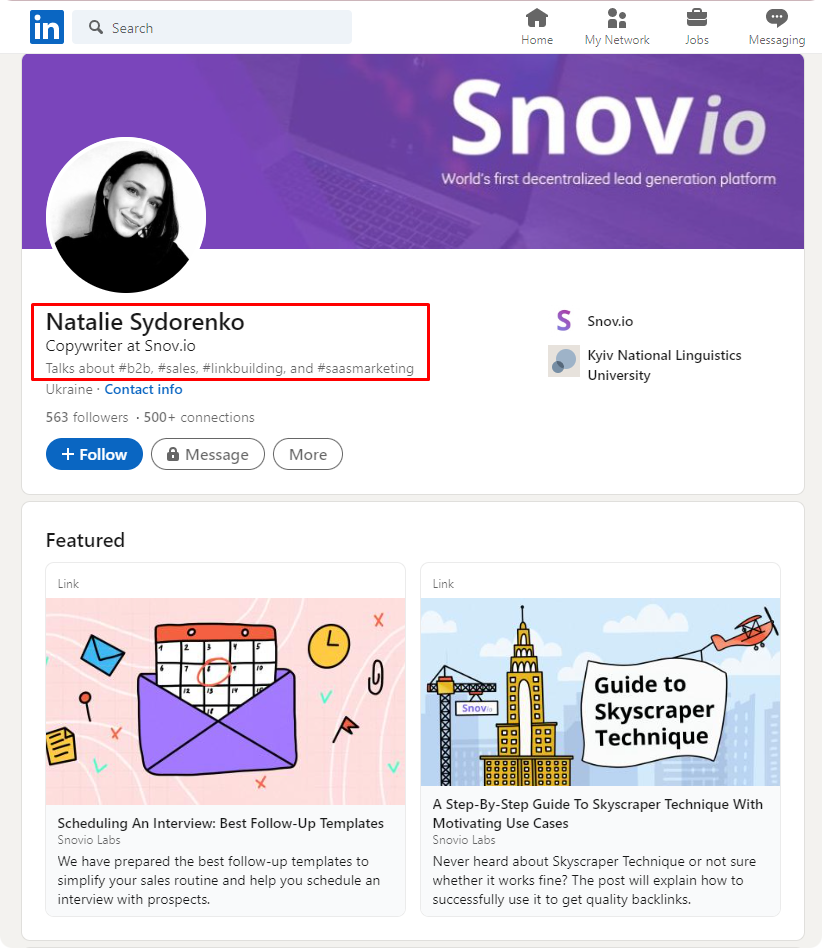
Use storytelling
Did you know that a great story can lead to the release of oxytocin, which creates a deeper connection between the storyteller and their audience? Not a surprise, storytelling is considered one of the most powerful sales techniques.
I highly recommend that you build your pitch around a narrative. Tell your prospect how other companies started using your product/service and what improvements they got. If you feel your prospect is inclined to object to your offering, you can even tell a brief story of how you have overcome problems by adopting a new technology after several objections.

Focus on the prospect
Even if you provide an example of your company in your sales pitch, make sure you don’t go too far telling your prospect about your best functionality for another long hour.
A good sales pitch is a story where the main hero is a prospect, not you. So concentrate on your prospect’s current challenges and the bright perspectives they’ll get when they buy your offering.
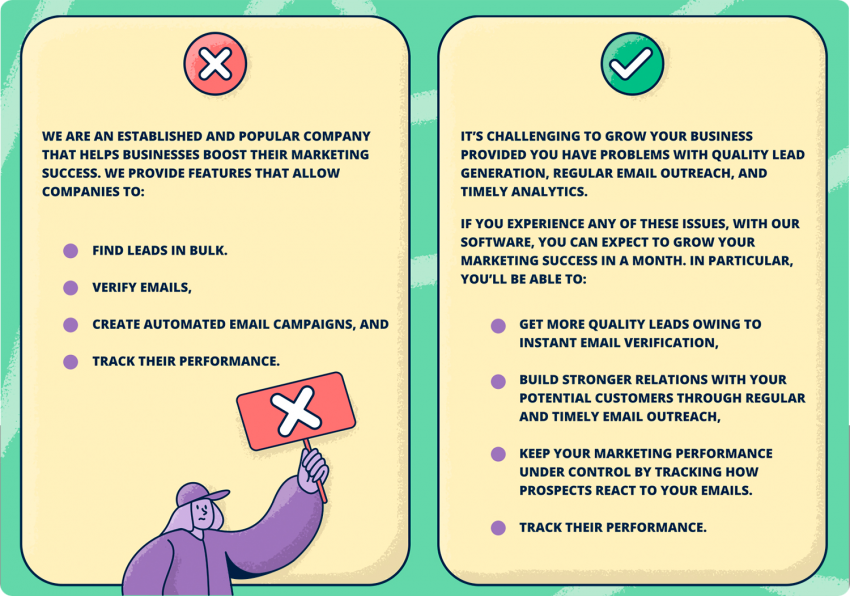
Balance between emotions and reason
In one of my previous posts about B2B sales psychology, I talked about the importance of appealing to emotions during a sales pitch. Here I would add that you should harmonize it with the appeal to the logical side.
You can appeal to emotions while talking about the prospect’s pain points, say, by asking them how they feel about their current problem. Or you can draw a positive picture of future improvements with your solution by asking them how they would feel if your product/service solved their problem.
But when it comes to proof, you should maximize your appeal to logic – by using facts, numbers, and analytics.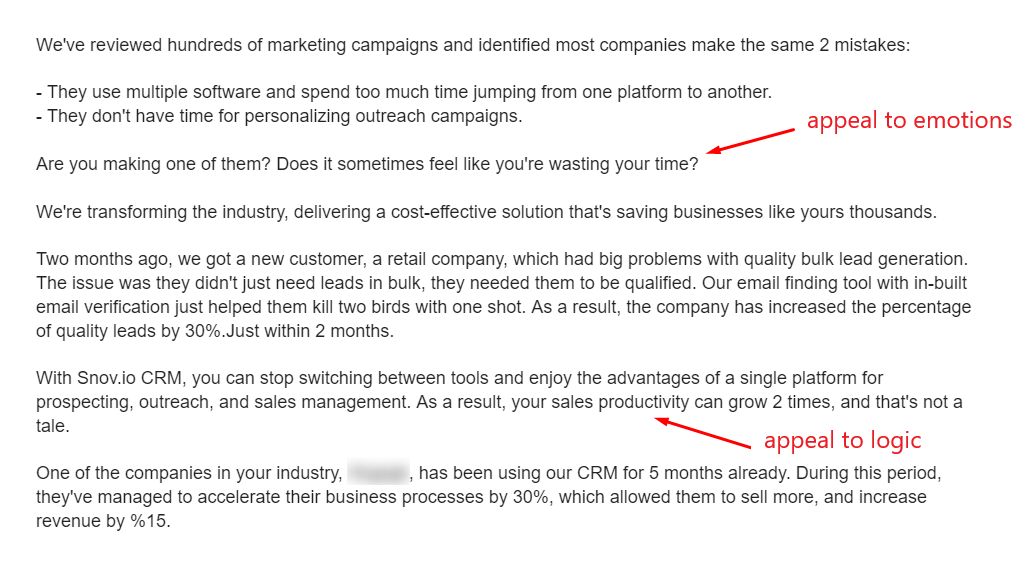
Create the FOMO effect
FOMO (fear of missing out) is a perception that you’re lagging behind others in experiencing the advantages of your current life. In sales, you can use the FOMO effect as a psychological trick to stimulate your prospect’s motivation to buy.
Try telling them success stories of direct competitors who have been using your product/service for a while. I’ve mentioned it in the previous chapter while talking about proof. This way, your prospects might feel anxious about missing out on something important their rivals already have in their pocket.

Personalize your sales pitch
Make sure your sales pitch is relevant to your prospect. Avoid a one-size-fits-all approach and focus on specific needs and pain points of a company you’re going to sell to. And let me remind you again: do research before you start your pitch and learn about your prospects, so you can address them personally, win their positive attitude, and build trust.

Educate
Another way to build trust with your prospects is to position yourself as an industry expert. Why not add interesting facts to your sales pitch that your prospective customer might not know about?
For example, if your offering concerns a sales CRM, you can add some general information about the CRM market or statistics about how companies are adopting a new CRM. That will show you are well-versed in the subject and only add to the value of your offering.

Be prepared to handle sales objections
It hurts, but your sales pitch won’t always be accepted as something your prospect has been waiting for. Prospects do object, and yes, they do it quite often. Just be prepared to come up with counter-arguments to back you up.
Collecting a list of typical sales objections is important to the process of strategizing your sales pitch. When you know how to handle objections quickly, you’ll appear more credible and professional to the prospect.
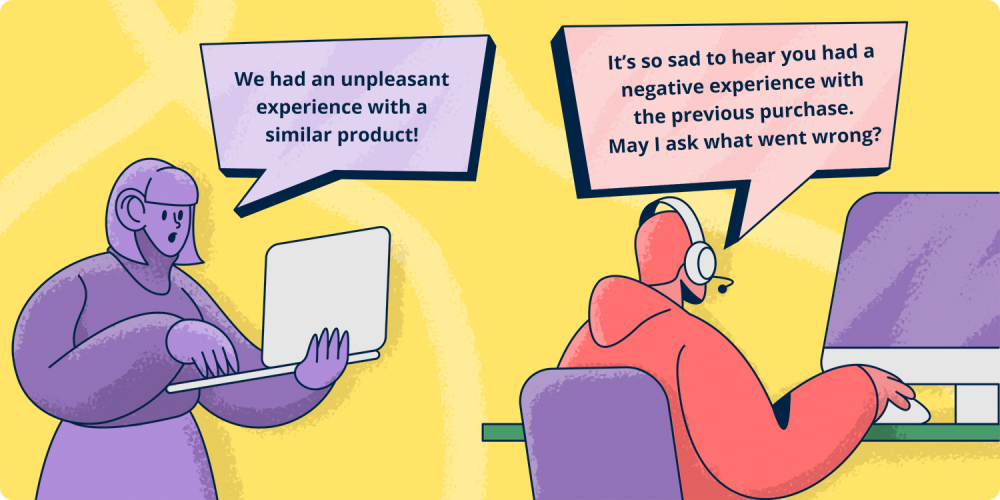
Practice
It might be strange to imagine yourself talking aloud, but you need to practice your sales pitch beforehand. Make a plan of your presentation, including all the elements mentioned above, and exercise what you’ll be saying, in what order, figuring out possible questions and prospects’ reactions to your sales pitch.
The top 5 sales pitch templates for your business
Wow, it seems you’re now ready to conquer the hearts of your prospects. Just one last bonus – I’ve prepared 5 templates to support your sales pitch email efforts.
Just remember: templates are fine, but your pitch must be highly personalized, so use them as convenient backing for your creativity.
Sales pitch email template #1 – Sales introduction
|
Hi [Prospect name], My name is [Your name], and I am [Your position] at [Your company]. I came across your website and found out that you’re [Prospect’s mission]. Looks like you might be dealing with many customers. Is it difficult to [Prospect’s pain point]? Our solution helps businesses in [Prospect’s industry] achieve three main goals:
We’ve helped [Prospect’s competitor], the company like yours, to [Benefit #1] and [Benefit #2]. If you are interested in [Positive results your prospect will gain], what about having a short call this week to discuss [Prospect company] improvement strategy? Best, [Your name] |
Use this template in case your prospect hasn’t heard about you before. Your key goal here is to give them a reason to start communicating with you, so prepare a hook and demonstrate you’ve done your homework, researching a company you’re going to pitch to.
Sales pitch email template #2 – Prospect’s website visit
|
Hi [Prospect name], My name is [Your name], and I am [Your position] at [Your company]. I noticed that some of your colleagues had visited our website and thought you might be interested in more details about what we’re doing. I have also looked through your site to gain a better understanding of how [Prospect’s mission]. [Your company] is cooperating with similar businesses in your industry, whom we help solve [Pain point] while providing them with the tools to [Value proposition]. We’ve helped [Prospect’s competitor] to [Benefit #1] and [Benefit #2]. What about having a 15-minute call to discuss how we can help [Prospect company] improve its business strategy? Best, [Your name] |
Never miss a chance to make a pitch to a prospect who has visited your website. You don’t need to look for a specific hook in this case, as you’ve got one already. This template will help show you are attentive to your website audience and ready to help immediately.
Sales pitch email template #3 – Responding to content
|
Hi [Prospect name], My name is [Your name], and I am [Your position] at [Your company]. I saw the [Content] your company published about [Subject] and was impressed by how you managed to explain such a complex subject with accessible language. Your product interested me greatly, so I studied what your company is doing. Looks like you are [Prospect’s pain point]. How do you feel about streamlining your processes in the future? [Your company] is cooperating with similar businesses in your industry, whom we help to [Benefit]. Would you be interested in having a 15-minute chat to discuss [Prospect company] improvement strategy? Regards, [Your name] |
Most of your prospecting customers are publishing regular content, usually blog articles. This is a wonderful opportunity to use one of their posts as a hook to build links and make a sales pitch.
Sales pitch email template #4 – LinkedIn connection email template
|
Hi [Prospect name], Thanks a lot for accepting my connection request on LinkedIn. I feel excited to see how your company is growing its product and helping other businesses to [Prospect’s mission]. I’d love to learn more about your success and challenges. I’m in [Your company’s industry], and I think [Your company] can help you [Benefit #1] and [Benefit #2]. Would you be interested in having a 15-minute chat to discuss [Prospect company] improvement strategy? Take care, [Your name] |
LinkedIn is one of the best platforms for getting new customers, so once your prospect has accepted your connection, you can use it as a hook for making a non-intrusive sales pitch. You can do this through LinkedIn messages, InMails, or email. The latter will be a better solution to deal with LinkedIn limits and restrictions.
Sales pitch email template #5 – Objection handling
|
Hi [Prospect name], Thanks for responding to my previous email. I see you aren’t sure whether you need [Your product] at the moment. It’s okay. Our company experienced the same feelings when we had to switch from the habitual strategy to automation. There were lots of fears: Will we indeed gain from it? How will it improve our productivity? Will we be able to increase our ROI? Doubts were gone when we first saw how the technology works and tried it ourselves. By the way, [Your company] offers a free trial so you can test the solution and make sure [Benefit] is more than reality. I suggest having a short video call during which I’ll show you how our product works in real-time, answer all your questions, and explain how you can try it free of cost. Feel free to pick a time on my calendar that works best for you, and I’ll follow up: [Meetings link]. Best, [Your name] |
This template will help you to stay in the game even after your prospect objects. As you see, a bit of storytelling can save the situation. If you don’t have a similar story to share, you can always use one of your customer’s use cases.
Wrapping up
A sales pitch is an inevitable part of your job as a sales rep. And while there are dozens of prospects who have negative associations with it (yes, just like me), you already know that making a good sales pitch is possible without being pitchy.
I hope all the above tips, examples, and templates will help you come up with a sales pitch that will melt your prospect’s hearts the way none ever did. Meanwhile, Snov.io will take care of your sales process from start to finish.






